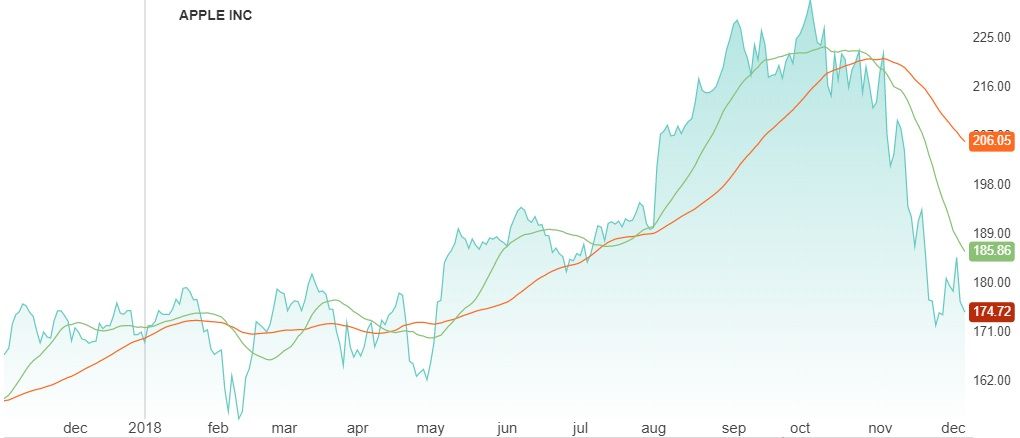Apple shares [APPL] have been hit hard in the past two months during the tech-led global sell-off spearheaded by FAANG stocks. November was the company’s worst month since the global 2008 financial crash, with Microsoft even momentarily surpassing it as the world’s most valuable company.
Apple had breached the $1tn mark just four months ago, before dropping to below $850bn. But since Black Friday and Cyber Monday at the end of November, the stock has been on the turnaround, popping 7% across the week following the sales. While some analysts expect the rebound to continue, there are a number of barriers to growth in 2019.

Apple share price performance, NASDAQ interactive chart, as at 7 December 2018
The vitals
Following a positive August earnings report, Apple shares went on a sharp upward trajectory, reaching a high of $232.07 in early October. But the growth hit a brick wall amid the wider tech sell-off; the downturn gathered pace from 1 November, when the company published Q4 results with a weak outlook that did little to impress investors.
In Apple’s Q4 earnings, it posted a revenue increase year-on-year of 20% to $62.9bn, with earnings per share up 41% to $2.91. For 2018, sales were up 15.8% year-on-year. Net income rose 23% over the same period. However, there were some concerns over the sales figures of the company’s new iPhones, and their price points. Apple’s P/E ratio is currently at 15 05, down from 19.02 in Q3.
| Revenue percentage change, Q4 YoY | +20% |
| Earnings per share (EPS) percentage change, Q4 YoY | +41% |
| Performance YTD | 4.8% |
| Market cap | $829.12bn |
| PE Ratio (TTM) | 14.67 |
Apple stock vitals, Yahoo finance, as at 7 December 2018
What’s been affecting performance?
1. Weaker demand for the latest iPhone
The latest iPhone model was priced high at a base cost of $999, while a number of suppliers of iPhone parts have cut their financial outlooks for the current quarter. Last quarter, iPhones accounted for approximately 60% of total revenue for Apple.
However, many customers are seemingly willing to pay significantly higher prices for Apple smartphones compared to the other market leaders. Furthermore, with the price increases, Apple’s revenue derived from iPhone sales rose 29% year-on-year, despite a stagnation in actual sales.
2. Service segment booms
Apple investors might also point to the continued growth of the company’s services, including App Store, Apple Music, Apple Pay and AppleCare. Revenue derived from this segment rose from $24.3bn in 2016 to $37.2bn, showing that under CEO Tim Cook, Apple is successfully diversifying its revenue streams in the face of a crowded smartphone market. Services is Apple’s second-biggest moneymaker and is on course to hit $50bn by 2020.
$50bn
Apple Services segment's estimated 2020 revenue
3. Global equities sell-off
The sell-off was led by tech (but not exclusive to the sector), with the S&P 500 losing 6.9% in ‘Red October’, with a significant contributory factor being concerns around high FAANG valuations. The prospect of the US Federal Reserve raising interest rates had also spooked investors, convincing some to sell. However, as this increasingly looks less likely, investor confidence has grown, and the S&P 500 as well as the tech-heavy NASDAQ, are back up once more.
Opportunity knocks?
Despite the recent sell-off, tech stocks have rebounded somewhat in the last few weeks. Following the G20 summit in which Trump and President Xi Jinping agreed to suspend the planned increase in tariffs to 25% from 10% for 90 days, there could be a marginally rosier outlook for global equities – and tech stocks more specifically – heading into 2019.
As the pandemonium around the stock continues, and sentiment towards it becomes increasingly negative as a result, Apple’s price-to-earnings ratio of 15.05 may be set to head even lower. CNBC’s Jim Cramer is betting that Apple is “buying back stock all the way down and could be a coiled spring on any good news, tariff or otherwise."
More generally, Caroline Simmons, deputy head of UBS Wealth’s UK investment office, labelled the recent sell-off a buying opportunity. She cited a recent, more conciliatory tone to US-China trade discourse, combined with more accommodative policy permeating from the Fed, as reasons for a potential uptick.
What’s next?
Apple is capable of battling against these major headwinds in what is a tough macro environment. The general downtrending of its stock doesn’t necessarily look over in the short term, especially with November being its worst in a decade, but its next results won’t be published until 1 February. By then the market might have equilibrated to pre-August levels at the very least, especially following the trade-war truce, meaning any good news has the potential to propel the stock price.
Continue reading for FREE
- Includes free newsletter updates, unsubscribe anytime. Privacy policy





